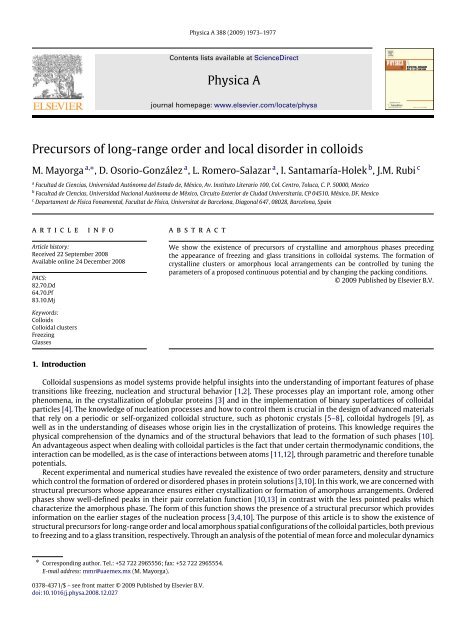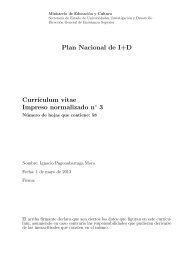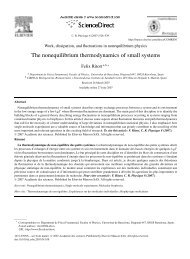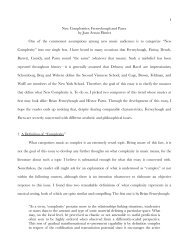Physica A Precursors of long-range order and local disorder in colloids
Physica A Precursors of long-range order and local disorder in colloids
Physica A Precursors of long-range order and local disorder in colloids
You also want an ePaper? Increase the reach of your titles
YUMPU automatically turns print PDFs into web optimized ePapers that Google loves.
M. Mayorga et al. / <strong>Physica</strong> A 388 (2009) 1973–1977 1975Fig. 1. Pair correlation function g(r) for our model potential plotted aga<strong>in</strong>st reduced distance r ∗ . At the pack<strong>in</strong>g fraction η = 0.494 <strong>and</strong> η = 0.545 wecan observe the appearance <strong>of</strong> the precursor <strong>and</strong> the presence <strong>of</strong> a structural <strong>long</strong> <strong>range</strong> <strong>order</strong>, respectively. The shoulder is practically flat, thus <strong>in</strong>dicat<strong>in</strong>gthat particles have a higher degree <strong>of</strong> pack<strong>in</strong>g. The <strong>in</strong>set enhances the split which resembles the structural precursor to freez<strong>in</strong>g observed <strong>in</strong> hard-spheresystems [16].Fig. 2. This image shows the translational <strong>long</strong> <strong>range</strong> <strong>order</strong> for the colloidal particles at η = 0.545, for the values <strong>of</strong> the parameters that were used toobserve the freez<strong>in</strong>g precursor.energy barrier correspond<strong>in</strong>g to the cluster<strong>in</strong>g process, <strong>and</strong> consequently to a decrease <strong>of</strong> the surface tension <strong>in</strong> accordancewith the classical theory <strong>of</strong> nucleation [13].The precursor <strong>of</strong> freez<strong>in</strong>g is manifested through the shoulder that appears on the left h<strong>and</strong> side <strong>of</strong> the second peak <strong>in</strong>Fig. 1, <strong>in</strong> the <strong>range</strong> <strong>of</strong> reduced distances (1.85, 1.95) which is <strong>in</strong>cluded <strong>in</strong> the correspond<strong>in</strong>g <strong>in</strong>terval found <strong>in</strong> Figure 6 <strong>of</strong>Ref. [16], obta<strong>in</strong>ed <strong>in</strong> the case <strong>of</strong> hard spheres. The shoulder, identical to the one reported for the hard sphere system at thesame pack<strong>in</strong>g fraction, namely η = 0.494, with α = 0.945 <strong>and</strong> β = 14.15, is the signature <strong>of</strong> the formation <strong>of</strong> crystall<strong>in</strong>eclusters <strong>and</strong> thus constitutes a crystall<strong>in</strong>e-structure precursor, <strong>in</strong> addition. For each time-step, we calculate the position <strong>of</strong>the particles from which we obta<strong>in</strong> the snapshot <strong>of</strong> the system show<strong>in</strong>g the presence <strong>of</strong> spatial <strong>and</strong> orientational <strong>order</strong>, aswe can see <strong>in</strong> Figs. 2 <strong>and</strong> 3. Once the precursor arises, cluster formation becomes favored by fix<strong>in</strong>g the value <strong>of</strong> β. Increas<strong>in</strong>gthe pack<strong>in</strong>g fraction <strong>of</strong> the system at the value η = 0.545, we obta<strong>in</strong> a tightly-packed hexagonal-closed array. This featurebecomes manifest <strong>in</strong> the dashed l<strong>in</strong>e <strong>in</strong> Fig. 1. On the other h<strong>and</strong>, for the above values <strong>of</strong> the potential parameters, theeffective width <strong>of</strong> the attractive well is less than one-third <strong>of</strong> the particle’s diameter. We observe, <strong>in</strong> addition, that thefreez<strong>in</strong>g precursor is still observed when the parameter β <strong>in</strong>creases, i.e. decreas<strong>in</strong>g the ratio effective width/diameter. Thislast situation is <strong>of</strong> <strong>in</strong>terest to colloidal systems with a very short-<strong>range</strong> attraction for which it is well known that there existonly two stable phases: fluid <strong>and</strong> crystal [19], or for <strong>colloids</strong> with an even narrower attractive well, with two solid phasesthat differ only <strong>in</strong> density [20].Follow<strong>in</strong>g a protocol similar to the one previously outl<strong>in</strong>ed, we observe a transition from an <strong>order</strong>ed structure forβ = 11.910 to the formation <strong>of</strong> amorphous clusters for β = 11.905 ma<strong>in</strong>ta<strong>in</strong><strong>in</strong>g the values α = 0.945 <strong>and</strong> the pack<strong>in</strong>g
1976 M. Mayorga et al. / <strong>Physica</strong> A 388 (2009) 1973–1977Fig. 3. This image shows a rotation <strong>of</strong> Fig. 2 from which one can better observe the presence <strong>of</strong> orientational <strong>long</strong> <strong>range</strong> <strong>order</strong>. The pack<strong>in</strong>g fraction is alsoη = 0.545 which corresponds to the same conditions given <strong>in</strong> Fig. 2 but the figure has been slightly rotated to capture the correspond<strong>in</strong>g view.Fig. 4. Pair correlation function for our model potential plotted versus reduced distance r ∗ , for two different β parameters. The cont<strong>in</strong>uous l<strong>in</strong>e is forβ = 11.910 <strong>and</strong> β = 11.905 for the dash l<strong>in</strong>e, for both cases α = 0.945 <strong>and</strong> η = 0.494. In this case, the shoulder is no <strong>long</strong>er flat. The particles becomearrested, giv<strong>in</strong>g rise to dis<strong>order</strong>ed configurations which have been found experimentally. The <strong>in</strong>set enhances the shoulder <strong>of</strong> the cont<strong>in</strong>uous plot whichshows qualitative agreement with the glassy precursor obta<strong>in</strong>ed experimentally <strong>in</strong> Refs. [17,21].fraction η = 0.494. The correspond<strong>in</strong>g correlation functions are shown <strong>in</strong> Fig. 4. This function is similar to the one observed<strong>in</strong> experiments for PMMA particles immersed <strong>in</strong> a mixture <strong>of</strong> decal<strong>in</strong> <strong>and</strong> cycloheptylbromide, that were reported <strong>in</strong> theFigure 4(b) <strong>of</strong> Ref. [17]. The lower value <strong>of</strong> β corresponds to an <strong>in</strong>crease <strong>of</strong> the diffusion <strong>of</strong> particles <strong>in</strong> comparison withthe <strong>order</strong>ed case. As a consequence, the shoulder <strong>in</strong> g appears at the right-h<strong>and</strong> side <strong>of</strong> the second maximum, lead<strong>in</strong>gto the appearance <strong>of</strong> cages, one <strong>of</strong> the features <strong>of</strong> <strong>colloids</strong> close to glass transition [17,21], which can be considered asa sign <strong>of</strong> an amorphous-structure precursor. The above observation establishes that there is a crystallization w<strong>in</strong>dow(i.e. β > 11.910) for which the crystallization can be <strong>in</strong>duced, <strong>in</strong>creas<strong>in</strong>g the volume fraction. So, decreas<strong>in</strong>g β belowthat value, the crystallization is frustrated, result<strong>in</strong>g <strong>in</strong> a dis<strong>order</strong>ed structure.4. ConclusionsWe have shown the existence <strong>of</strong> structural precursors <strong>of</strong> <strong>long</strong>-<strong>range</strong> <strong>order</strong> <strong>and</strong> <strong>local</strong> dis<strong>order</strong> <strong>in</strong> <strong>colloids</strong>, which can beidentified as shoulders around the second peak <strong>in</strong> the pair correlation function. The presence <strong>of</strong> a shoulder on the left (right)side is the signature <strong>of</strong> <strong>long</strong>-<strong>range</strong> <strong>order</strong> (<strong>local</strong> dis<strong>order</strong>) <strong>in</strong> colloidal suspensions. Its position depends on the value <strong>of</strong> as<strong>in</strong>gle parameter that modulates the effective width <strong>of</strong> the attractive well <strong>in</strong> the <strong>in</strong>teraction potential. These <strong>in</strong>terest<strong>in</strong>gf<strong>in</strong>d<strong>in</strong>gs may contribute to a deeper underst<strong>and</strong><strong>in</strong>g <strong>of</strong> the models that can be proposed to study phase transitions <strong>in</strong> colloidalsuspensions [22].
M. Mayorga et al. / <strong>Physica</strong> A 388 (2009) 1973–1977 1977AcknowledgmentsWe would like to thank S. Torquato, D. Frenkel <strong>and</strong> A. van Blaaderen for <strong>in</strong>terest<strong>in</strong>g discussions. We want to acknowledgef<strong>in</strong>ancial support <strong>of</strong> PROMEP <strong>and</strong> grants UAEM 2263/2006, CONACyT P/49607 <strong>and</strong> by DGICYT <strong>of</strong> the Spanish Governmentunder Grant No. FIS2005-01299.References[1] K.H. L<strong>in</strong>, et al., Phys. Rev. Lett. 85 (2000) 1770.[2] P.G. Vekilov, Cryst. Growth Des. 4 (2004) 671.[3] J.F. Lutsko, G. Nicolis, Phys. Rev. Lett. 96 (2006) 046102.[4] D. Frenkel, Nature Mater. 5 (2006) 85.[5] W.K. Kegel, A. van Blaaderen, Science 287 (2000) 290.[6] A. Yethiraj, J.H.J. Thijssen, A. Wouterse, A. Van Blaaderen, Adv. Mater. 16 (2004) 596.[7] T.F. Krauss, Nature Mater. 2 (2003) 777.[8] J. Gao, Z. Hu, Langmuir 18 (2002) 1360.[9] J. Wu, G. Huang, Z. Hu, Macromolecules 36 (2003) 440.[10] L.F. Filobelo, O. Galk<strong>in</strong>, P.G. Vekilov, J. Chem. Phys. 123 (2005) 014904;W. Pan, A.B. Kolomeisky, P.G. Vekilov, J. Chem. Phys. 122 (2005) 174905.[11] A. Ben-Naim, Hydrophobic Interactions, Spr<strong>in</strong>ger, 1980.[12] J.N. Israelavichli, Intermolecular <strong>and</strong> Surface Forces, Academic Press, San Diego, 1995.[13] D. Kashchiev, Nucleation, Basic Theory <strong>and</strong> Applications, Butterworth-He<strong>in</strong>emann, Oxford, 2000.[14] M. Mayorga, L. Romero-Salazar, J.M. Rubi, <strong>Physica</strong> A 307 (2002) 297.[15] D. Osorio-González, M. Mayorga, J. Orozco, L. Romero-Salazar, J. Chem. Phys. 118 (2003) 6989.[16] T.M. Truskett, S. Torquato, S. Sastry, P.G. Debenedetti, F.H. Still<strong>in</strong>ger, Phys. Rev. E 58 (1998) 3083.[17] E.R. Weeks, D.A. Weitz, Phys. Rev. Lett. 89 (2002) 095704.[18] R. Verberg, I.M. de Schepper, E.G.D. Cohen, Phys. Rev. E 61 (2000) 2967;R. Verberg, I.M. de Schepper, E.G.D. Cohen, Phys. Rev. E 55 (1997) 3143.[19] H.N.W. Lekkerkerker, W.C.K. Poon, P.N. Pusey, A. Stroobants, P.B. Warren, Europhys. Lett. 20 (1992) 559.[20] P. Bolhuis, D. Frenkel, Phys. Rev. Lett. 72 (1994) 2211.[21] E.R. Weeks, J.C. Crocker, D.A. Weitz, J. Phys. Cond. Matt. 19 (2007) 205131.[22] J.R. Savage, D.W. Blair, A.J. Lev<strong>in</strong>e, R.A. Guyer, A.D. D<strong>in</strong>smore, Science 314 (2007) 795.





